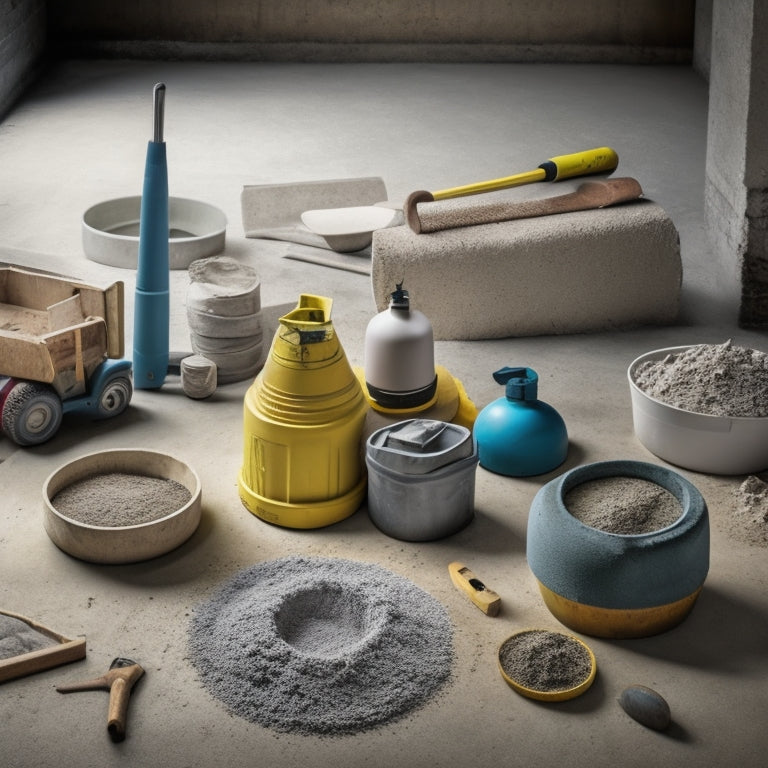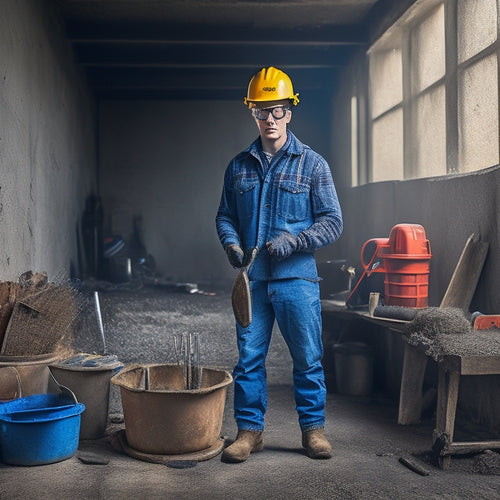
5 Best Tools for a Beginner's Concrete Project
Share
When starting a concrete project, you'll need essential tools to guarantee a successful outcome. Begin with protective eyewear, sturdy gloves, and a dust mask/respirator to prioritize safety. For a smooth finish, invest in a polishing machine, such as a walk-behind or ride-on model. A dedicated edging tool will help create precise cuts, and grinding/sanding essentials like angle grinders and orbital sanders will refine your surface. Finally, measuring/testing tools like a tape measure, concrete level, and surface profiler will guarantee accuracy. With these tools, you'll be well-equipped to tackle your project - and understanding how to use them effectively will take your results to the next level.
Key Takeaways
• Invest in protective gear, including impact-resistant eyewear, sturdy gloves, and a dust mask/respirator, to ensure personal safety.
• Choose a polishing machine suitable for your project size, and master a sequence of progressively finer grits for a high-quality finish.
• Select a dedicated edging tool based on concrete type and desired edge profile, and practice a steady hand for precise cuts.
• Use a variety of grinding and sanding tools, including angle grinders and orbital sanders, and master wet sanding techniques for a smooth finish.
• Essential measuring and testing tools, such as a tape measure, concrete level, and surface profiler, help ensure accuracy and durability in your project.
Essential Safety Gear for Beginners
Wearing essential safety gear is crucial when working with concrete, as it protects you from the harsh effects of cement, aggregate, and other hazardous materials that can cause serious injuries or long-term health problems.
You'll need protective eyewear to shield your eyes from flying particles and chemical splashes. Look for eyewear with impact-resistant lenses and a snug, comfortable fit.
Sturdy gloves are also a must-have, providing a barrier against skin irritation and abrasion. Opt for gloves made from durable materials like leather or synthetic fabrics, and choose a pair that fits comfortably to guarantee dexterity.
In addition to protective eyewear and sturdy gloves, consider investing in a dust mask or respirator to filter out airborne particles.
Steel-toed boots or shoes with slip-resistant soles will help prevent slips and falls. Don't forget to wear long-sleeved shirts, long pants, and a hat to protect your skin and hair from exposure.
Polishing Machines for Smooth Finish
To achieve a high-gloss, showroom-quality finish, you'll need to invest in a reliable polishing machine that can efficiently remove imperfections and progressively refine the concrete's surface.
When selecting a polishing machine, consider the type of concrete you're working with and the desired finish. There are two primary machine types: walk-behind and ride-on. Walk-behind machines are ideal for smaller areas and offer more control, while ride-on machines are better suited for larger projects and provide increased efficiency.
Mastering various polishing techniques is vital to achieving a high-quality finish. You'll need to develop a sequence of progressively finer grits to remove imperfections and scratches. Start with coarse grits (16-30) to remove major imperfections, then shift to finer grits (60-120) for a higher luster. Finally, use a polishing compound to achieve a mirror-like finish.
When operating your polishing machine, maintain a consistent speed, apply moderate pressure, and make overlapping passes to guarantee an even finish.
Edging Tools for Precise Cuts
You'll need a dedicated edging tool to create precise cuts and define the edges of your concrete project, as a high-quality finish demands clean, sharp lines. A high-quality edging tool will help you achieve professional-looking concrete borders and decorative edging.
When selecting an edging tool, consider the type of concrete you're working with and the desired edge profile. For example, a diamond-edged tool is ideal for creating sharp, precise cuts in thick concrete, while a carbide-edged tool is better suited for thinner concrete.
When using an edging tool, maintain a steady hand and apply gentle to moderate pressure, depending on the tool's specifications. It's crucial to keep the tool straight and level to guarantee clean, even cuts.
To achieve a decorative edge, use a tool with an angled or curved blade, and apply gentle pressure in a consistent, sweeping motion. By mastering the use of edging tools, you'll be able to create stunning concrete borders and decorative edging that elevate your project's overall aesthetic.
Grinding and Sanding Essentials
Grind away imperfections and smooth out rough surfaces with the right grinding and sanding tools, which are essential for refining your concrete project's texture and appearance.
You'll need a combination of grinder types, including angle grinders, die grinders, and orbital sanders, to tackle different tasks. Angle grinders are ideal for removing excess material and rough edges, while die grinders are better suited for precision work and detail sanding. Orbital sanders, on the other hand, provide a smooth finish and are great for large, flat surfaces.
Master various sanding techniques to achieve the desired finish. Start with coarse grits (around 40-60) to remove imperfections, then progress to finer grits (80-120) for a smooth finish. Use a wet sanding technique to reduce dust and prevent scratches.
Always work in a circular motion, applying gentle to moderate pressure. Don't forget to change your sanding discs frequently to maintain efficiency and prevent overheating.
Measuring and Testing Tools Required
Measuring and Testing Tools Required
With your concrete surface now refined and smooth, it's time to confirm it meets precise specifications, which requires the right measuring and testing tools to verify dimensions, levels, and surface quality.
You'll need tools that can accurately measure and test various aspects of your concrete project. Here are some essentials to include in your toolkit:
| Tool | Purpose | Recommended Type |
|---|---|---|
| Tape Measure | Measure lengths, widths, and heights | 25-foot or 30-foot fiberglass tape |
| Concrete Level | Ensure surface is level and plumb | Digital laser level or spirit level |
| Density Tester | Verify concrete density and compaction | Nuclear density gauge or non-nuclear density gauge |
| Surface Profiler | Measure surface roughness and texture | Digital surface profiler or concrete surface profiler |
These measuring and testing tools will help you achieve a high-quality concrete finish that meets your project's specifications. Remember to choose tools that are durable, accurate, and easy to use, even for a beginner.
Frequently Asked Questions
Can I Use Regular Gloves Instead of Concrete-Specific Gloves?
When working with concrete, you might wonder if regular gloves will suffice, but don't compromise on safety precautions.
Concrete-specific gloves are designed to protect your hands from harsh chemicals and abrasion. Regular gloves lack the necessary glove materials, such as puncture-resistant palms and waterproof coatings, to shield your skin from alkaline-based concrete.
Invest in concrete-specific gloves to guarantee your hands remain safe and healthy throughout the project.
How Do I Prevent Staining From Oil-Based Concrete Stains?
Imagine a delicate watercolor painting - you wouldn't want it to bleed or smudge, right?
That's exactly what can happen with oil-based concrete stains if you don't take preventative measures. To avoid staining, you'll want to apply a concrete sealer or a barrier coat before staining. This creates an impermeable layer, preventing the oil-based stain from penetrating the concrete.
Additionally, perform a test patch to guarantee the stain doesn't bleed or feather excessively, giving you a professional-looking finish.
What Is the Ideal Temperature for Pouring Concrete?
When you're ready to pour concrete, you'll want to guarantee ideal pouring conditions.
Temperature plays a vital role in concrete setting and curing. Ideally, you'll want to pour when the ambient temperature is between 50°F and 75°F (10°C and 24°C).
Temperature effects can be significant: too hot, and the concrete sets too quickly; too cold, and it sets too slowly.
You'll achieve the best results by pouring within this ideal temperature range.
Can I Use a Regular Drill for Mixing Concrete?
When you're mixing concrete, you'll need a drill that can handle the heavy load.
Using a regular drill won't cut it - you'll risk burning out the motor or damaging the gears.
Instead, opt for a heavy-duty drill or a mixer specifically designed for mixing concrete.
These drill types are built to withstand the intense mixing techniques required for a successful pour.
How Long Does It Take for Concrete to Fully Cure?
As you begin your concrete journey, remember that patience is the unsung hero of a successful project.
When it comes to the curing process, you'll need to let time do its magic. Typically, it takes around 28 days for concrete to fully cure, but this can vary depending on factors like temperature and moisture retention.
Make sure you maintain ideal conditions, and your concrete will transform from a fragile paste to a robust, long-lasting masterpiece.
You're not just building a structure; you're crafting a work of art that'll stand the test of time.
Conclusion
You've got the basics covered, now it's time to bring your concrete project to life.
With these five fundamental tools, you'll be forging a flawless finish, crafting crisp cuts, and fine-tuning your fabrication.
From safety gear to polishing machines, edging tools to grinding essentials, and measuring masters, you're now equipped to conquer any concrete creation.
Confidently craft, carefully carve, and meticulously mold your way to a masterpiece.
Related Posts
-

What Tools Do I Need for Concrete Wall Repair
As you prepare for a concrete wall repair job, you'll need a variety of tools to guarantee a successful outcome. Star...
-

7 Must-Have Tools for Concrete Repair Organization
To effectively organize your concrete repair projects, you'll need a thorough toolkit that includes a well-planned st...
-

Why These Tools Are Crucial for Concrete Patio
You're about to commence on a concrete patio project, and having the right tools is vital to achieving professional-l...


